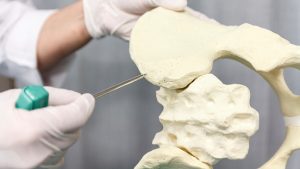 Osteomyelitis (staph bone infection) may be treated with a new model discovered in previous research. It is an infection of the bones caused by Staphylococcus aureus, which reaches the bones through the bloodstream or nearby tissue. If the bone itself is permeated by germs, it can become infected.
Osteomyelitis (staph bone infection) may be treated with a new model discovered in previous research. It is an infection of the bones caused by Staphylococcus aureus, which reaches the bones through the bloodstream or nearby tissue. If the bone itself is permeated by germs, it can become infected.
Adults are more likely to develop osteomyelitis in the bones that make up the spine, and diabetics can develop it in their feet bones if they have pre-existing ulcers.
Advertisement
Osteomyelitis used to be an incurable condition, but modern medicine is able to treat it. In some cases, surgery may be required to remove the infected bone, followed by antibiotics to aid in treatment.
Osteomyelitis treated by new model: Previous study
Previous research found a new form of treatment for osteomyelitis that involves testing with a new mouse model. Researcher Dr. James Cassat developed micro-computed tomography (micro-CT) imaging technologies to visualize a surgically induced bone infection.
“The micro-CT gives excellent resolution images of the damage that’s being done to the bone. We found that staph is not only destroying bone, but it’s also promoting new bone growth. Staph is causing profound changes in bone remodeling,” said lead researcher Eric Skaar, Ph.D.
“We’re not aware of any other bone infection models where you can pull the bacteria out of a bone and count them in a highly reproducible manner. From a therapeutic development standpoint, we think this model is going to allow investigators to test new compounds for efficacy against bone infections caused by staph or any other bacteria that cause osteomyelitis,” added Skaar.
The use of the model allowed researchers to demonstrate a certain protein secreted by staph, which plays a role in osteomyelitis. Understanding bacterial factors could help researchers develop new and more effective treatments.
Causes and symptoms of osteomyelitis
Osteomyelitis is commonly caused by the bacteria Staphylococcus aureus, or staph infection. The bacteria that travels through the blood stream gets to the bone through surrounding tissue, which causes the infection. Pneumonia, an abscess tooth, or even a urinary tract infection can all lead to osteomyelitis.
Symptoms of osteomyelitis can vary, beginning with pain, difficulty or inability to use the affected limb, or ability hold or apply weight to the affected limb due to increased pain.
Some symptoms occur rapidly and others may appear gradual; a fever may develop along with chills, irritability, swelling or redness, stiffness, and nausea.
There are two types of osteomyelitis: acute and chronic. In acute osteomyelitis, symptoms are sudden, and in chronic, the symptoms appear gradually and may reoccur even when treated with antibiotics.
Risk factors and complications of osteomyelitis
Osteomyelitis is avoidable, but there are certain conditions and factors that increase a person’s risk of developing it. Risk factors of osteomyelitis include:
- Recent injury or surgery
- Circulation disorders
- Problems with intravenous or catheters
- Conditions that impair the immune system
- Illicit drugs
If osteomyelitis is not properly treated, it can lead to complications including the following:
- Bone death, which may mean the bone needs to be surgically removed
- Septic arthritis, where the infection spreads to the joints
- Impaired growth
- Skin cancer
Diagnosing bone infection
If you are experiencing any of the mentioned symptoms, your doctor may perform a combination of assessments to determine whether or not you have a bone infection. These tests include:
Blood tests: A simple blood test in which a sample of blood is drawn through a thin needle and sent to a lab may reveal higher levels of white blood cells—an indication that your body is fighting an infection. This test may also show what germs are causing the infection, though there is no specific test to indicate osteomyelitis with certainty. Your doctor will likely conduct one or more other diagnostic methods to confirm if the infection is due to osteomyelitis.
Imaging: An X-ray may show damage to the bone, though this damage can sometimes not be visible unless osteomyelitis has been present for a period of weeks. If your doctor believes your osteomyelitis is in earlier stages, they may use a CT or MRI scan to check for damage, as these imaging methods can produce better quality images as well as more detailed cross-sections.
Biopsy: To gather a bone biopsy, a doctor will most likely administer anesthesia, as this is an invasive procedure. An open biopsy is a surgical procedure where the surgeon has access to the bone and can take a sample. Another option to gather a bone sample is to insert a long needle through the skin. This method uses local anesthetic to numb the region where the needle is inserted.
Related: 8 ways your bones change as you age
Prevention and treatment of osteomyelitis
Advertisement
There are many treatment options available in order to treat osteomyelitis. Some of those treatments include antibiotics administered intravenously, or surgery to remove any dead bone. If osteomyelitis occurs after a joint replacement, the replaced joint may need to be removed and a new one must be used.
Prevention techniques include properly cleaning any open skin wounds right away, wearing proper footwear to avoid injury and preventing other infections that can increase the risk of staph infections. This means always properly washing your hands as well as cooking food properly.
As osteomyelitis may have many serious complications, it is best you do your part in preventing it at all costs.
